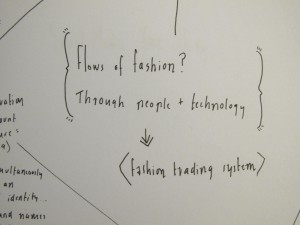
Vintage appeal… Clare Press in her Oxford Street boutique.
Photo: Tamara DeanTraditional stores are turning to new tactics in a bid to compete with the online fashion phenomenon, writes Natasha Silva-Jelly.
Blame it on the global financial crisis, the rise of the mega-mall, the online shopping revolution or our sky-high dollar but the boutique retail sector is suffering. Clothing and footwear sales declined 4.8 per cent in the year to December and a stroll down any of Sydney’s once-burgeoning shopping precincts will reveal a stream of sale signs and, worse, empty stores.
In the latest twist, retailers have resorted to charging try-on fees in store, which are refunded upon purchase, to stop consumers heading online to search for the same item at a lower price.
Besieged by the new world of e-commerce, it is no longer enough for traditional bricks-and-mortar stores to fill their racks and then wait for the customers to roll in.

Robby Ingham’s store in Paddington.
Photo: Tamara Dean”E-commerce is growing at an exponential rate,” says Katherine Milesi, a partner at Deloitte’s Online Practice, which delivers and implements digital strategies for a number of fashion retailers. Speaking at an e-tail seminar in Melbourne last month, Milesi described the internet shopping boom as ”the black swan Australia did not see coming”.
But she believes high-street retailers can coexist happily with the new digital platform. The key to success, Milesi says, is to ensure they differentiate what they provide and the way they provide it.
”Our advice is to create a multi-channel offering where the store, internet and social networking go hand in hand,” she says.

Belinda Seper hosts special events to draw shoppers.
Photo: Tamara Dean”Retailers could encourage customers to go online to browse and then insist they pick up in-store. Or provide an online kiosk inside the store where shoppers can view extended ranges that they can only order online.”
Forced to employ such strategies, niche boutiques and single-brand retailers are becoming increasingly creative about ways to lure consumers away from the keyboard.
”I love having a store because I have an old-fashioned sensibility,” says Sydney designer Clare Press, who opened her Mrs. Press vintage-inspired store on Paddington’s Oxford Street nine months ago. ”I love the traditional shopping experience, a delicious environment, boutique rather than mass, special treatment and a sensory hit that you can’t get online. But as a designer with one store, we have become a destination so you have to work hard as customers are no longer going to walk past and buy a dress on a whim.”
When customers do enter, the fact Press’s work studio is above her store means she is on hand to offer personalised service. She has also created an inviting sensory environment: the boutique smells of magnolia candles and is kitted out like a 1920s boudoir, complete with a black spiral staircase and a gold-velvet theatre chair, and is brimming with vintage treasures collected over the past decade.
”Our clients describe the store as being very European and the decor is all part of the experience,” Press says.
So are the regular salon shows (the most recent to launch the latest racing collection by milliner Suzy O’Rourke), champagne and macaroon shopping nights for VIPs, trend talks by fashion media and a style blog written by Press, a former features director for Vogue Australia.
Also sharpening up their service and rethinking their offering are our well-known luxury fashion retailers, which now find themselves pitted against hugely popular online sites net-a-porter.com and shopbop.com.
”We haven’t changed our philosophy, we don’t sell online, but we have changed the way we market to clients,” says Sydney retail veteran Robby Ingham. ”We have a blog, we email and now we text [customers] the same day new stock arrives.”
Ingham’s high-end Paddington boutique is home to labels such as Stella McCartney, Alexander Wang and Givenchy and has been a Sydney shopping hot spot for 28 years.
”Service has always been at the heart of our business,” he says. ”Going in-store allows you to feel the garment, see the proper colour and fit and bring it back if something goes wrong. We can also do alterations and offer advice on how to maintain pieces.”
Trawling the globe to unearth new and unique labels that suit the Sydney market and regularly changing the mix to keep the offering interesting is core to the sales strategy, as is extensive refurbishment of the store last year to ”refresh the brand and remind customers we’re here”.
”We also have designer meet-and-greets and give our VIPs early notice when a new collection arrives and offer pre-selling,” Ingham says. ”The internet is not going away and as long as international sites are not taxed like an Australian business, they will always have a 20 per cent advantage.”
But the web is ”also a fantastic medium to find out about new labels and keep up with the latest fashion blogs, so you have to go with it”.
The chain of Belinda and The Corner Shop boutiques owned by Belinda Seper in Sydney and Melbourne will soon enter the online shopping space.
But for now the focus remains on enticing customers into the stores via film and fashion nights, photography exhibitions, personal stylists on hand and at-home wardrobe overhaul sessions, should you require the store to come to you.
Seper also employs one-off initiatives such as a tea salon that has been set up at The Corner Shop boutique in Paddington this month, along with VIP launches to showcase new designers, most recently Britain’s Erdem and Christopher Kane.
On the more affordable high street, Sportsgirl is one of the best examples of a retailer that is embracing e-commerce but also updating its bricks-and-mortar stores. Sportsgirl offers a buzzing in-store environment, trendy staff, a dizzying array of well-merchandised racks and a specialised vintage section. It also has services including ”chill out” rooms and ”style me” studios where shoppers can indulge in a one-on-one styling session that is difficult to replicate in cyberspace.
But the long-established chain store has certainly given it a try: the Sportsgirl website features global style reports, a section to learn about Sportsgirl events in your area, regular competitions and blogs and even Sportsgirl TV.
Together, the stores and the website offer a whole-of-brand experience that constitutes an ideal meeting of in-store and online.



 Vintage appeal… Clare Press in her Oxford Street boutique. Photo: Tamara Dean
Vintage appeal… Clare Press in her Oxford Street boutique. Photo: Tamara Dean Robby Ingham’s store in Paddington. Photo: Tamara Dean
Robby Ingham’s store in Paddington. Photo: Tamara Dean Belinda Seper hosts special events to draw shoppers. Photo: Tamara Dean
Belinda Seper hosts special events to draw shoppers. Photo: Tamara Dean







